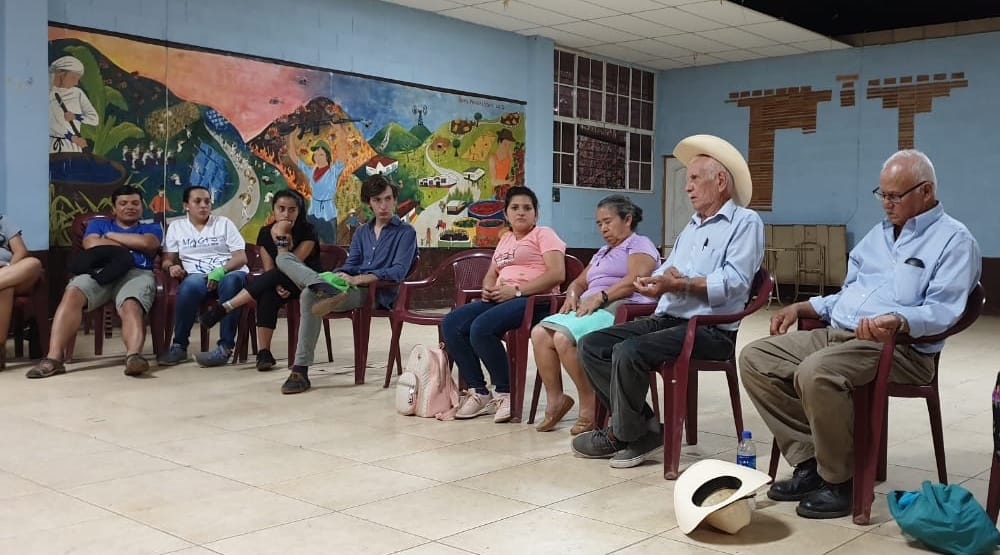Haga clic aquí para español.
From January 12-18, pilgrims from across the world gathered in Central America for MAG+S, an activity that takes place the week before World Youth Day begins. MAG+S helps pilgrims to know the social, cultural and religious reality of the country and the different apostolic activities where the Society of Jesus has a presence. This year, MAG+S was carried out in five countries of Central American: Guatemala, El Salvador, Honduras, Costa Rica and Panama.
We would like to share the experience of three Jesuit scholastics from the Central American Province who traveled to El Salvador to collaborate in the various activities of MAG+S. The program in El Salvador was divided into 12 experiences in different regions of the country. Some of the themes included: spirituality, art, culture, cooperatives and historical memory. Each experience was marked by the presence of the Jesuit martyrs, St. Óscar Romero and many Jesuits and lay people who work to accompany a people full of hope and love.
In this article, we will share experiences from three departments of the country: Cabañas, Sonsonate and Chalatenango.
Location: Santa Marta, Cabañas, El Salvador
By: Benjamín Sánchez Selva S.J.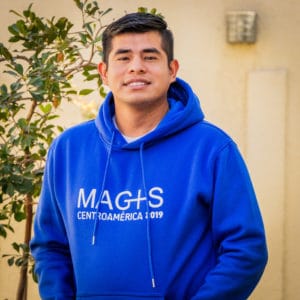
The experience in Santa Marta was marked by the story of their flight and return to the country. MAG+S pilgrims learned about the history of Santa Marta, a community that returned from exile and that was born as a result of the signing of the peace accords in 1992. This happened after the civil war from 1980-1992, which resulted in conflict between rural communities and the army. This fact brought about the death of so many Salvadorans who gave their lives for peace in their country. Likewise, it led to the departure of many people, who had no other choice but to flee and, only little by little, years later, they returned to El Salvador. Thus, the objective of this experience was to know the historical memory that gives meaning to life in this community.
We shared with families, toured the community and visited the Lempa river, where one of the great massacres occurred (the total number of dead, according to official figures given by the population, is around three hundred killed). This happened when the people fled the army towards Honduras, due to the great physical violations that the military was carrying out, especially against those aligned with the guerrillas, as well as local catechists and community activists. Learning this story was a key part of our experience.
Santa Marta reminded all of us who lived the experience of the Hebrew people. Like the Hebrew people, Santa Marta was first born as an exiled product of war, in which the Salvadoran army had decided to end all life in the region. This extermination campaign was called “tierra razada” (“wasteland”). But also, like the Hebrew people, the people of Santa Marta eventually arrived at a land that is fruitful and holy. This allowed Santa Marta to stay organized as a community and overcome the sufferings of the war.
Father Alberto S.J., a Jesuit from Spain, said in one of his homilies in the community that Santa Marta was a “holy land.” I think that’s exactly right. I had the joy of being in a land where so many men and women shed their blood to see their people free, but also a people full of solidarity with one another. This is what made the land holy. I remember the moment when, in a conversation with the community, one of the pilgrims asked: “How did you survive so long? How were you able to defend yourselves?” The community answered: “The Gospel, that’s what we had. The Gospel and the homilies of Archbishop Romero. With this, we knew what we had to do if we wanted to live or give our lives for our people.”
“A people that does not know its history is condemned to repeat it.” This was another phrase repeated by the people of Santa Marta. The goal of the community is to keep its historical memory alive. Thus, the community has a social organization that works with children, youth and adults. From the community cooperative, they get the necessary tools to pass on this history, while at the same time creating together a more united and exemplary community. For example: the community has helped support many young people so that they can carry out their university studies, and these young people are now helping the development of the community. This is most evident in the local health clinic and school, which are led primarily by professionals who are originally from the community.
The experiences of the community have been an encounter with a God who accompanies a suffering people, but a people full of much hope. Santa Marta is the story of a living God, a God of love. Each face, each look: although they carry a history of pain, they also display a profound joy knowing that, in the hands of God, it is always possible to move forward and organize to build a just and supportive community.
All of us pilgrims have felt extremely grateful to God and to the community for the opportunity to live MAG+S here. It was the best experience for us in El Salvador. People opened their hearts to us, and before such generosity, we let ourselves be filled with their love. Santa Marta is an experience of the MAG+S (“more”) to which we are all invited. Santa Marta remains in our hearts, and it inflamed in us the drive to continue, in each of our home countries, to struggle for justice and peace with ever more fervor.
Location: Sonsonate, El Salvador.
By: Abiud Alejo Rolón Macías, S.J.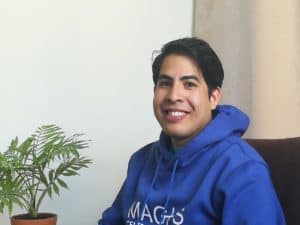
Lord, you are our Father; we are the clay, and you are the potter. We are all the work of your hand. Is 64:7
It was the clay that truly marked the experience of youth from Spain, El Salvador, Colombia, Argentina and Mexico who participated in MAG+S in the community of Sonsonate, El Salvador.
During the days of MAG+S we came to know what it means to work the clay: not only to know ourselves in the hands of God, but also to be potters along with others, especially with the members of the community who opened the doors of their homes and their lives to us.
Little by little we were shaping our shared heart with the pain of a people crucified by insecurity, lack of opportunities, migration and death. We also share those earthen vessels where each one keeps a great treasure and puts it at the service of others. The MAG+S youth were confronted with a reality that is not unlike their home countries, but at the same time, it motivated them to continue working to build a world of equality and justice, especially remembering all those social activists who have died in defense of the most vulnerable, including the martyrs of the UCA, St. Óscar Romero and so many martyrs of El Salvador, witnesses to the God of life.
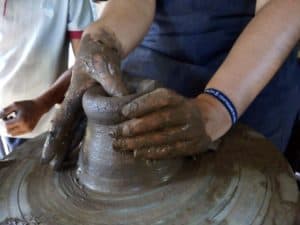 During the experience, we had the opportunity to work with clay with a family of potters in the community of Santo Domingo de Guzmán, which has a strong indigenous tradition and Nahuat speakers (the local native language).
During the experience, we had the opportunity to work with clay with a family of potters in the community of Santo Domingo de Guzmán, which has a strong indigenous tradition and Nahuat speakers (the local native language).
We visited the municipality of Izalco to learn about and commemorate the “massacre of 32,” known as such because of the murder of many natives in the year 1932. The locals remember their loved ones with a ceremony using the Mayan altar on the graves where they are buried. In addition, we helped collect the mud to make adobe for the construction of a center that will work to pass on indigenous traditions and preserve the historical memory of the community.
Among other activities, we visited the Agape nursing home to spend time with the residents, especially with the much-anticipated rounds of Lottery (i.e. Mexican bingo). At the Cóbanos beach, we organized a clean-up project. We also learned the technique for dying with indigo, a blue pigment used to paint clothes. Lastly, we met with youth of the Eucharistic Youth Movement (EYM), and played games and icebreakers, ate together, and learned the traditional dances of the region.
Location: Chalatenango, El Salvador.
By: Juan Callejas, S.J.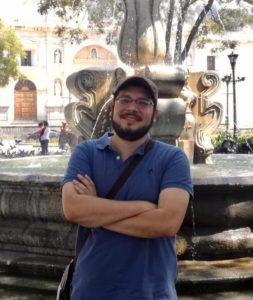
To visit El Salvador is to encounter a people impoverished, marginalized, tortured and killed, but a people who have risen and shown the world their glorious wounds. Where there was repression, war, and death, now there is life and life in abundance. Listening to their stories and history causes astonishment for those who have never experienced similar situations. Their testimonies are a call to hope for the world: war and violence will never be the solution to conflicts; but peace will be, and justice and social movements as well. From a spiritual perspective, to be in El Salvador is to listen to the risen Jesus saying to the apostle Thomas: “Put your finger here and see my hands; bring your hand and put it in my side, and do not be unbelieving, but believe.”
The experience in which I participated was that of historical memory in the municipality of San José las Flores in the department of Chalatenango, El Salvador. This municipality intimately lived the bloody civil war that hit El Salvador between the years 1980-1992. It forced its inhabitants to leave their homes in 1982, and for four years the civilian population wandered the countryside, fleeing bullets and the repression of the Salvadoran army with U.S. backing. In the year 1986, the population returned to their homes and began to rebuild the community.
We arrived at the community as a group of twenty-one pilgrims on Sunday, January 13, 2019, from four different nationalities: Colombians, Spaniards, Salvadorans and Mexicans. In the town of San José las Flores, Mrs. Zoila Guardado, a representative of the community, greeted us. We settled in at the community center and went to enjoy the welcoming banquet that they had prepared for us. In the afternoon, Mrs. Zoila Guardado took us on a tour of the small community of around 1,500 residents. In the public square, Zoila G. told us about the history of the town and how they had survived the war. In the central square of the community, she showed us the remains of bombs and war mortars. They keep them as a visual testimony that the use of weapons only leads to destruction and not to peace.
On January 14, we made a pilgrimage to a hill located 5 km from the community, known as “the hill of Los Urbina.” On this hill an image of the Virgin Mary was placed, popularly known among the inhabitants as the Virgin of the Resistance. It gets its name from what happened in 2005 with the mining company Martinique Minerals of El Salvador S.A. de C.V., a subsidiary of the Canadian company Pacific Rim, which in 2013 was acquired by Oceana Gold. The company tried to buy the lands of the peasants of San José las Flores and other nearby municipalities to begin to exploit gold and silver deposits among other minerals found in the area. The inhabitants of San José las Flores organized together, and with the help of NGOs and the Catholic Church, they were able to face this company by stopping the mining exploitation. In response to this struggle, the Salvadoran government passed the metal mining ban into law in March 2017. As a symbol of that struggle, the image of the Virgin was placed on the hill and each year pilgrims go to the place to commemorate the ban on mining. In this spot, the pilgrims were given a small talk about the resistance to mining. One of the young men asked Don Amado Valles, the guide and a member of the resistance committee: “Why didn’t you sell your land to the mining companies?” Don Amado responded, “Because this land is sacred to us. These hills have the blood of our parents, children, brothers and relatives who died in the war so that we could have peace. Mining comes and destroys, contaminates and divides peoples. They say they bring progress when in reality they bring destruction, disease, contamination and death.”
After the pilgrimage to the hill of the Virgin of the Resistance, we had a conversation with the leaders of the community who told us about the importance of caring for the land and their community. They told us how they had organized and had won a battle against a monster called “Metal Mining,” but that they will continue fighting for the common good. Don Lisandro Monge explained that the struggles were motivated from the love of their children, brothers, community, ancestors, and the earth itself. Without love nothing was possible, with love everything could be achieved. The human and spiritual experience of the community permeated the group of pilgrims. All recognized the importance of organization, love of the land, and the establishment of peace as paths of integral human development.
In the subsequent days, we made a mural at the entrance of town supporting care for the land and against mining, highlighting the importance of care of our common home. There was also a cleaning day on the banks of the Sumpul River since the care of nature is everyone’s responsibility. Finally, the young people of the community organized games and activities with the pilgrims, playing, singing, dancing, as a single community without distinction of culture and nationality. It was a celebration of friendship and fraternity; the young Christ was there. The experience of the Risen One incarnate in the inhabitants of San José las Flores inflamed the hearts of the pilgrims. All returned to San Salvador happy to see a social, religious and cultural dawn in San José las Flores. The martyr people, as they define themselves, showed us that life always triumphs over death. Peace and justice were, are, and ever will be the horizon for their community, always at the service of the Lord Jesus and the Gospel.

